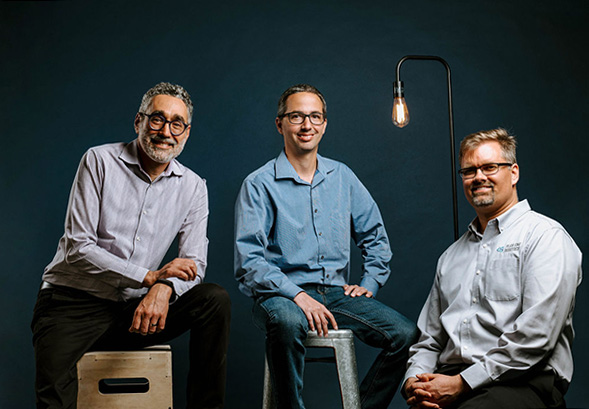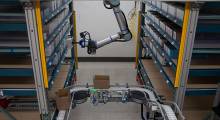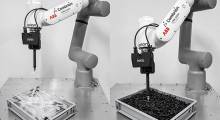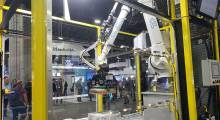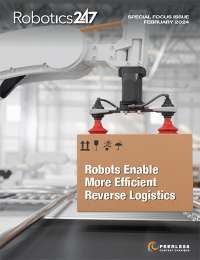Plus One Robotics, which provides vision software for logistics robots, today said it has raised $33 million in Series B funding. The San Antonio-based company said the funding will support its ongoing expansion in the U.S. and Europe, as well as continued product development.
“We’re fortunate to work with customers at the leading edge of warehouse automation who share our values of 'Robots Work, People Rule,'” stated Erik Nieves, co-founder and CEO of Plus One Robotics. “Like our clients, our investors have a global footprint representing Asia and the EU, as well as North America. This potent combination sets Plus One on a course to continue growing our international installed base.”
Computer vision and robotics industry veterans founded Plus One Robotics in 2016 to bring artificial intelligence and 3D vision capabilities to warehouse automation. The company's approach to human-robot collaboration includes round-the-clock robot supervision enabling workers to manage industrial robots remotely.
Plus One expects humans in the loop
Plus One said its PickOne software works with any robot, gripper, and cloud service to enable robots to precisely perform a range of warehouse tasks. The company's Yonder system uses human intelligence to handle exceptions for the variety of items passing from dock to door. One crew chief can manage up to 50 robots remotely, said Plus One.
“Our approach to keeping a human in the loop is not as a patch, but as our fundamental belief,” Nieves told Robotics 24/7. “There was a time when we were a voice crying in the wilderness. We saw that in others' funding rounds, where they hung out a shingle promising full autonomy and lights-out AI and got buckets of money. It's gratifying to see other folks now getting on board with humans in the loop.”
“As for mobile manipulation, if you take an AMR [autonomous mobile robot] with two and a half degrees of freedom [DoF] and add a six-DoF arm, the edge cases multiply,” he said. “For mobile manipulation, you absolutely have to have a human in the loop.”
Market small but growing
“It was a seminal moment when A3's [the Association for Advancing Automation] numbers came out last year, noting that non-automotive robot sales surpassed automotive,” Nieves said. “While that won't be the case every year, it will be the case more often going forward.”
“The robotics industry is still small—there are just 3 million industrial robots in the world,” he noted. “A 400- to 500-unit order can swing the market substantially. The vision-guided manipulation space for warehouses has the potential to be just as large. Plus One is playing in a huge landscape.”
“It's early for the warehouse space,” added Nieves. “For example, you could sell a bad robot, and a major automaker would still buy more, but if you sell a bad robot to a warehouse, you've ruined it for 10 years.”
How are various regions different in terms of warehouse automation needs? “U.S. warehouses tend to be larger, but the overall industry is larger abroad,” Nieves said. “There are more warehouses in Europe and people working in them than in North America. We can't be the world's most important robotic vision company without a presence in Europe.”
“In Asia, we can't be outflanked by startups coming out of there,” he said. “We need to know what's happening, and I'm a big fan of the logistics work being done there.”
Tapping the VC network
Raising money during the COVID-19 pandemic can be challenging for robotics startups, with meetings curtailed and many companies chasing e-commerce order fulfillment. Fortunately, Plus One could rely on its experience and network of contacts.
“Plus One has been around for a while—since 2016, with a seed round in 2017,” recalled Nieves. “We've had benefit of investors watching us for some time. You can only get so far on the hype of the team and the expected technology. You have to show that you're delivering.”
“The venture capital network is its own ecosystem,” he said. “If you make the early investors look smart, the rest becomes easy, but the process always takes longer than you'd think. Fundraising is a full-time job.”
McRock Capital and Translink Capital co-led the round, with participation from BMW i Ventures, Kensington Capital Partners, Perot Jain, and Ironspring Ventures, as well as existing investors. Whitney Rockley of McRock Capital and Toshi Otani of Translink Capital will join Plus One's board of directors.
“The Plus One team has done an excellent job aggressively growing its business over the past two years,” said Rockley. “Their market traction and customer base validates the need for logistics automation using agnostic, scalable applications.”
“With their precision and quality, Plus One is positioned to be an integral part of any system in e-commerce fulfillment and distribution center,” Otani said. “We’re excited to play a part in this growth, as well as their growth in the Asian markets.”
“We believe that Plus One Robotics' technology will usher in a new era of smart, adaptive robot systems to bring automation to new heights across supply chain, logistics, and manufacturing,” said Kasper Sage, a partner at BMW i Ventures. “The beauty of Plus One's technology is that it combines state-of-the-art computer-vision algorithms with a human-in-the-loop approach, enabling robots to operate at accuracy and throughput levels currently unmatched in the industry.”
Plans for depalletization, global support
“Part of the proceeds from this round will go toward developing our depalletizing product,” said Nieves. “We have a very strong offering in parcel handling, but depalletizing is much more ubiquitous as an application.”
“There's more to being an enterprise-grade player than making sure our 3D vision software doesn't crash,” he added. “We know how to structure contracts in a way that it's a win-win. Plus One will answer the phone when you need us and show up with the right parts. Any expansion will always include tech support.”
“Scaling robotic automation in warehouses is not an AI or ‘big data’ challenge; it’s an industrial-grade, systems integration challenge,” said Ty Findley, managing partner at Ironspring Ventures.
Plus One Robotics plans to hire more engineers and sales staff worldwide, according to Nieves. “We'll be at 60 people before the end of the year,” he said. “The bulk will be in San Antonio, but there will be some international growth. Our investors look like our clients, in terms of global operations. Plus One has to support them all.”
About the Author
Follow Robotics 24/7 on Linkedin
Article topics
Email Sign Up

